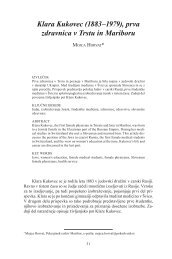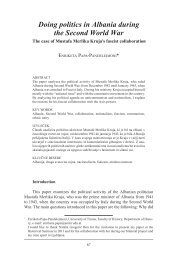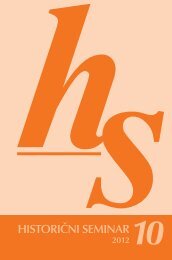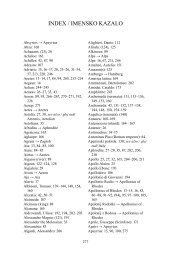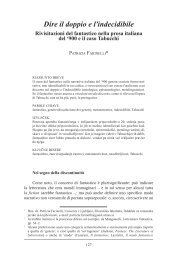The Habsburg Most Illustrious Order of the Golden Fleece: Its ...
The Habsburg Most Illustrious Order of the Golden Fleece: Its ...
The Habsburg Most Illustrious Order of the Golden Fleece: Its ...
You also want an ePaper? Increase the reach of your titles
YUMPU automatically turns print PDFs into web optimized ePapers that Google loves.
<strong>The</strong> <strong>Habsburg</strong> <strong>Most</strong> <strong>Illustrious</strong> <strong>Order</strong> <strong>of</strong> <strong>the</strong> <strong>Golden</strong> <strong>Fleece</strong> ...<br />
In potential operation here are two social <strong>the</strong>ories: elite <strong>the</strong>ory and status<br />
<strong>the</strong>ory.<br />
Elite <strong>the</strong>ory postulates that <strong>the</strong> power structure <strong>of</strong> society is dominated<br />
by a certain minority group or class that rules despite electoral results and<br />
o<strong>the</strong>r democratic tools and can be characterized as monopolizing political,<br />
economic, or social influence. Eva Etzioni-Halevy noted that Bourdieu introduced<br />
<strong>the</strong> concept <strong>of</strong> “cultural capital” to <strong>the</strong> equation, that is, a cultural<br />
elite. Meant by this, according to Etzioni-Halevy, is that “[m]embers <strong>of</strong> this<br />
class can thus use <strong>the</strong>ir cultural capital to perpetuate and reproduce <strong>the</strong>ir<br />
dominant class position: <strong>the</strong>y appear distinguished (that is, <strong>of</strong> dominant class<br />
affiliation) simply by being <strong>the</strong>mselves (that is, by giving outward indication<br />
<strong>of</strong> <strong>the</strong>ir cultural capital). And <strong>the</strong>y produce <strong>the</strong>ir position in large part by<br />
transmitting this cultural capital to <strong>the</strong>ir children, through education.” 28 All<br />
<strong>of</strong> <strong>the</strong> Knights I have interviewed have acknowledged that <strong>the</strong>y do talk about<br />
<strong>the</strong> <strong>Order</strong> with <strong>the</strong>ir children.<br />
For <strong>the</strong> <strong>Habsburg</strong> empires, <strong>the</strong> greatest symbol <strong>of</strong> elite cultural capital<br />
were <strong>the</strong> insignia <strong>of</strong> <strong>the</strong> <strong>Order</strong> <strong>of</strong> <strong>the</strong> <strong>Golden</strong> <strong>Fleece</strong>, <strong>the</strong>reby meaning that<br />
wearing <strong>the</strong> insignia was <strong>the</strong> presentation <strong>of</strong> distinction <strong>of</strong> <strong>the</strong> dominant class:<br />
<strong>the</strong> Catholic royal and aristocratic houses. <strong>The</strong>refore, related to elite <strong>the</strong>ory is<br />
status <strong>the</strong>ory, which for us translates into symbols <strong>of</strong> status. As Peter Lauster<br />
explained, “Status symbols should show who one is; <strong>the</strong>y should document<br />
<strong>the</strong> actual or desired social position. That is wanted not only by elites, as it is<br />
held as a common human phenomenon that goes through all social levels.” 29<br />
<strong>The</strong>se <strong>the</strong>ories do not always hold true in reality. For example, <strong>the</strong> idea<br />
<strong>of</strong> status <strong>the</strong>ory can be at odds with socially accepted behavior or affiliations,<br />
especially in modern society. As Prince Lorenz noted, “If I would be<br />
a king, I would never go to <strong>the</strong> thing [Feast Day celebration], if I know that<br />
<strong>the</strong> television would be <strong>the</strong>re. Because I know I would have a lot <strong>of</strong> critic in<br />
my country, that I belong to a little thing, which is out <strong>of</strong> time, [that] I’m old<br />
fashion, I’m conservative, and so forth.” 30 Could such judgment by critics be<br />
wrong? Perhaps <strong>the</strong>y could be, along <strong>the</strong> lines <strong>of</strong> <strong>the</strong> misperceptions mentioned<br />
above.<br />
Not all <strong>the</strong> Knights hold this position, however. In contrast to Prince<br />
Lorenz, Duke Georg von Hohenberg explained what he “found is <strong>the</strong> right<br />
thing. <strong>The</strong> occasion, which is <strong>the</strong> Holy See, or <strong>the</strong> Sovereign, you carry it<br />
with <strong>the</strong> “Frack” (white tie), or a family “Fest” (festival/party) or whatever.” 31<br />
Prince Hugo Windisch-Graetz seemed to have <strong>the</strong> same opinion. 32 <strong>The</strong>se<br />
opinions are put into practice at least as far as <strong>the</strong> wearing <strong>of</strong> <strong>the</strong> miniature<br />
28 Etzioni-Halevy, <strong>The</strong> Elite Connection, p. 19.<br />
29 Lauster, Statussymbole, p. 11.<br />
30 Interview with Prince Lorenz <strong>of</strong> Belgium.<br />
31 Interview with Duke Georg von Hohenberg.<br />
32 Questionnaire from Prince Hugo Windisch-Graetz.<br />
51




